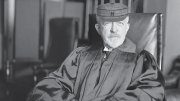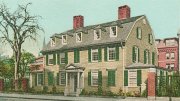Harvard Alumni take all kinds of paths to the College. Few equal the one Bob Bowie Jr. ’73 describes in The Older You Get the Shorter Your Stories Should Be (Salt Water Media), collecting his best yarns. Bowie, a self-described “playwright; poet; recovering lawyer,” ascended to the Alumni Association (HAA) presidency in 2010-2011, but it took his gift of gab, and audacious hard work, to get there.
“I was a townie from birth,” he writes in the chapter titled “How the Hell Did You Get into They’a”—but one with an affliction: “It took me several expulsions, numerous worthless summer schools with worthless speed reading classes if you were a dyslexic” (his condition long went undiagnosed), and, in all, six years to get through high school. While repeating eleventh grade, he called on David King “Deke” Smith ’58, Ed.M. ’64, in admissions, to present his candidacy for the College, only to be told that with no grade higher than a C+ he’d never make it. Undaunted, he appeared before Smith again as a senior; applied; and was rejected.
So, “I went off to a wonderful school in Ohio,” where in September 1970 Bowie “was in a high-speed motorcycle crash, which killed the driver, my friend.” After months of recuperation, he returned to Cambridge. On crutches, he badgered Smith again, seeking “special student” status to take one course, and was permitted to do so. He enrolled in five, studied like mad, enlisted his mother to type his papers (to conceal his execrable spelling)—and pulled off A’s, B’s, and one C+. Thus equipped, he reapplied and was admitted as a transfer student, the first step toward his A.B. cum laude. Harvard, he writes, “gave me a chance that others wouldn’t.”
Thus launched, he took a law degree, practiced, sold his firm, and devoted himself to his true love as a playwright, and of late as HAA “poet laureate”—an honorary and fun role that, he wrote elsewhere, is “not really a path to Houghton or the Lamont Library’s Poetry Reading Room.”
The authorship of “Casey at the Bat” is not in question: Ernest Lawrence Thayer (A.B. 1885, schooled at the Lampoon and Hasty Pudding), then concluding his service as humor columnist for fellow Lampoon member William Randolph Hearst’s San Francisco Examiner, is responsible for there being “no joy in Mudville.” But who was Casey?
Ross E. Davies proposes a novel theory in Casey at the Bat and the Supreme Court (Green Bag Press). He is triply credentialed for the task, professing law at George Mason’s Scalia Law School and editing the Journal of Supreme Court History; twice a Society for American Baseball Research honorand; and, in an investigative mode, serving as an “invested member” of the Baker Street Irregulars.
He advances the notion that the inspiration was Edward Terry Sanford, A.B. 1885, A.M.-LL.B. ’89, LL.D. 1924, who overlapped with Thayer at the College from 1883 to 1885 and much later served as an associate justice of the U.S. Supreme Court. Although legal scholars will know his majority opinion in Gitlow v. New York (1925), this newer identification as the primordial Casey may do more to shape his future legacy if the Davies sleuthing sticks. That takes a willingness to accept “plenty of circumstantial evidence”—but readers will in any case be rewarded by the accompanying Harvard arcana, with dandy photos of the baseballers of the era, Holmes Field, and more.
Historian Jeffrey Boutwell, a distant cousin of his subject, has just published Boutwell: Radical Republican and Champion of Democracy (W.W. Norton), the first full biography of George Sewall Boutwell, an abolitionist, founder of the Republican Party, Secretary of the Treasury, U.S. Representative and Senator, and more. In this column, he matters as a (Democratic) Massachusetts governor who supported the Harvard Reorganization Act (1851).
At issue was the College’s status as a public institution (per the Commonwealth’s 1636 charter) which, in the view of critics, had become captured by Whigs and, the author writes, “the Boston mercantile and professional elite.” The law aimed to “‘democratize’ and ‘secularize’ the institution” by reforming the Board of Overseers: changing the mode of election and eliminating the mandatory number of clerical members.
Although the law has been criticized somewhat for impinging on Harvard’s academic freedom, the place has obviously survived without noticeable harm attributable to the Boutwell-era lawmaking. Given the current political climate, with the threat of far more hostile legislation emanating from the nation’s capital (see “At Risk,” page 4), Harvard should be so lucky again.








